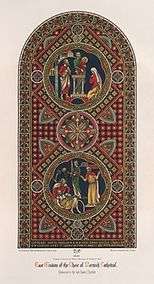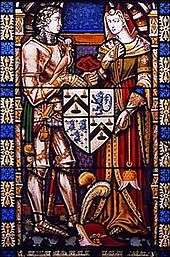William Warrington
William Warrington, (1796–1869), was an English maker of stained glass windows. His firm, operating from 1832 to 1875, was one of the earliest of the English Medieval revival and served clients such as Norwich and Peterborough Cathedrals. Warrington was an historian of medieval glass and published an illustrated book The History of Stained Glass.

Biographical



In his youth, Warrington first trained with his father as a painter of armorial shields. He then moved for a time into the stained glass workshop of Thomas Willement, one of the earliest such workshops to be of high renown. In 1832 Warrington established his own stained glass company, where he produced windows that well satisfied the rising fashion of Gothic Revival and in which his own skills as an armorial painter were utilised in the production of domestic as well as ecclesiastical windows.
From studying existent ancient windows and emulation of the leading techniques of the master Thomas Willement, Warrington developed a style which allowed him to create windows strongly resembling those of the 13th and 14th centuries in appearance. His windows became the preferred choice of the architect Augustus Welby Pugin who used them in most of his earliest churches, between 1838 and 1842.
But Pugin was soon to fall out with Warrington, claiming “The Glass-Painters will shorten my days, they are the greatest plague I have. The reason I did not give Warrington the window at the hospital is this. He has lately become so conceited and got nearly as expensive as Willement.”[1] Warrington produced drawings of windows to be used by Pugin in the Houses of Parliament, but the firms that Pugin employed were Ballantine and Allen and Hardman & Co.
In 1848 Warrington published “The History of Stained Glass, from the Earliest Period of the Art to the Present Time” . The book came out in a folio edition with coloured lithographs illustrating British stained glass windows from the 11th to the 15th centuries. However Warrington expressed his dislike of the glass of the centuries that followed as being "a misconception and misapplication of this art."
Among Warrington's significant commissions was the tiered arrangement of windows for the Eastern Apse of Norwich Cathedral. He also designed for Ely Cathedral, where his work may still be seen, both installed and on display in the Stained Glass Museum.
After Warrington's death in 1869, the firm continued until 1875.
Style
Warrington was able to reproduce closely the geometric and foliate backgrounds of the 13th century and create pictorial rondels composed of small pieces of glass that gave a similar impression to the Medieval originals, though tending to let through more light and have less luminosity, because the nature of the glass was less flawed and therefore less refractive. Warrington's windows often contain a background comprising a distinctive pattern of little red and blue diagonal checks which was copied from medieval originals. Many of Warrington's Gothic Revival windows have a pleasant simplicity about them, the stylised foliage which takes up much of the window space being less heavy in appearance than some of his rivals, such as Clutterbuck, and based more closely upon recognisable plants.
The balance and arrangements of pictorial scenes within their formal background shows Warrington as a much more skilful designer than his teacher Willement, in whose windows the overall arrangement has a fairly arbitrary quality. Warrington's figurative painting strives towards the Medieval in its forms, which are somewhat elongated and elegant, with simply-painted drapery falling in deep folds in such a way that line and movement is emphasised in the pictorial composition. His painting of the details, particularly of faces, is both masterly and exquisite. Towards the end of his career he also designed windows in a more painterly and less Gothic manner to suit changing tastes.
Buildings containing windows by Warrington

- Ely Cathedral and also in the Stained Glass Museum at Ely Cathedral.
- St Mary's College Oscott, near Birmingham - windows of saints designed by Pugin, made by Warrington, 1838.
- St. Mary's R.C. Church, Sutton Coldfield, West Midlands - windows designed by Pugin, made by Warrington, 1838.
- St Mary, Salehurst - a large 5 light West Window showing Christ before Pilate, Christ carrying the Cross, the Crucifixion, Noli me tangere and Ascension.
- St. Margaret's Church, Addington, Kent - the East window, 3 lights of the Ascension
- St George's, Brede, Sussex - has three windows
- All Saints’, Lindfield, Sussex - has three windows.
- St Andrew's, Hove - 2 windows, the Raising of Lazarus and the Raising of Jairus’ Daughter.
- St John's, Deptford - one window, Presentation in the Temple.
- Norwich Cathedral - The windows of the Apsidal Eastern End.
- Thornton College, Buckinghamshire - figurative, decorative and armorial windows.
- Basilica Cathedral of St. John the Baptist, St. John's, Newfoundland and Labrador, Canada - 7 windows
- Presentation Convent, Cathedral Square, St. John's, Newfoundland and Labrador, Canada - 2 windows in Oratory Chapel, 1 window (three lights) in central hall
- St Peter's, Heversham, Cumbria - 5 light East window of Jesus and the Gospel writers.
- Lissadell Parish Church, Church of Ireland - a number of windows by Warrington
- St Mary Magdalene, Albrighton, Wolverhampton. Signed window in south chancel
- St. Anne's Chapel (Fredericton) has a triplet window by Warrington in the chancel
St. John's Horninglow, Burton on Trent - five-light east window illustrative of the life of St. John the Evangelist. Given by Mr. H. E. Smith, Shelbrook House, Ashby de la Zouch[2]
- Mount St Bernard Abbey, Coalville, Leicestershire - quatrefoil window in original nave
- All Saints Church, Leamington Spa (Leamington Priors) - two South Aisle windows (St James the Great, St John the Evangelist). St Peter missing since 1903. South Apse and South Chancel Clerestory 13 scenes of the life of Jesus re-set 1900 from original West window; one scene, Christ before Pilate, is missing.
Other Early 19th century studios
See also
- Stained glass
- Stained glass - British glass, 1811-1918
- Victorian Era
- Gothic Revival
References
- extract from a letter by Pugin in the Victoria and Albert Museum, London
- Burton Chronicle 25 October 1866 page 4
- Painton Cowen, A Guide to Stained Glass in Britain, 1985, Michael Joseph, ISBN 978-0-7181-2567-7
- Elizabeth Morris, Stained and Decorative Glass, Doubleday, ISBN 978-0-86824-324-5
- Sarah Brown, Stained Glass- an Illustrated History, Bracken Books, ISBN 1-85891-157-5
- Simon Jenkins, England's Thousand Best Churches, Allen Lane, the Penguin Press, ISBN 978-0-7139-9281-6
- John Harvey, English Cathedrals, Batsford, 1961, ISBN unknown
- Robert Eberhard, Church Stained Glass Windows,
- Cliff and Monica Robinson, Buckinghamshire Stained Glass,